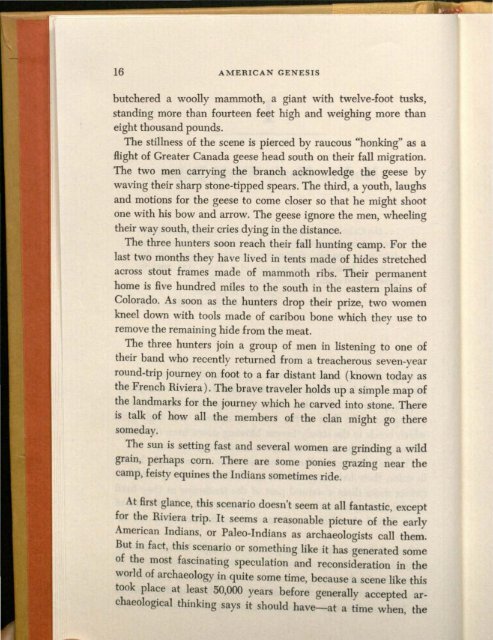Create successful ePaper yourself
Turn your PDF publications into a flip-book with our unique Google optimized e-Paper software.
16 AMERICAN GENESIS<br />
butchered a woolly mammoth, a giant with twelve-foot tusks,<br />
st<strong>and</strong>ing more than fourteen feet high <strong>and</strong> weighing more than<br />
eight thous<strong>and</strong> pounds.<br />
<strong>The</strong> stillness <strong>of</strong> <strong>the</strong> scene is pierced by raucous "honking" as a<br />
Bight <strong>of</strong> Greater Canada geese head south on <strong>the</strong>ir fall migration.<br />
<strong>The</strong> two men carrying <strong>the</strong> branch acknowledge <strong>the</strong> geese by<br />
waving <strong>the</strong>ir sharp stone-tipped spears. <strong>The</strong> third, a youth, laughs<br />
<strong>and</strong> motions for <strong>the</strong> geese to come closer so that he might shoot<br />
one with his bow <strong>and</strong> arrow. <strong>The</strong> geese ignore <strong>the</strong> men, wheeling<br />
<strong>the</strong>ir way south, <strong>the</strong>ir cries dying in <strong>the</strong> distance.<br />
<strong>The</strong> three hunters soon reach <strong>the</strong>ir fall hunting camp. For <strong>the</strong><br />
last two months <strong>the</strong>y have lived in tents made <strong>of</strong> hides stretched<br />
across stout frames made <strong>of</strong> mammoth ribs. <strong>The</strong>ir permanent<br />
home is five hundred miles to <strong>the</strong> south in <strong>the</strong> eastern plains <strong>of</strong><br />
Colorado. As soon as <strong>the</strong> hunters drop <strong>the</strong>ir prize, two women<br />
kneel down with tools made <strong>of</strong> caribou bone which <strong>the</strong>y use to<br />
remove <strong>the</strong> remaining hide from <strong>the</strong> meat.<br />
<strong>The</strong> three hunters join a group <strong>of</strong> men in listening to one <strong>of</strong><br />
<strong>the</strong>ir b<strong>and</strong> who recently returned from a treacherous seven-year<br />
round-trip journey on foot to a far distant l<strong>and</strong> (known today as<br />
<strong>the</strong> French Riviera). <strong>The</strong> brave traveler holds up a simple map <strong>of</strong><br />
<strong>the</strong> l<strong>and</strong>marks for <strong>the</strong> journey which he carved into stone. <strong>The</strong>re<br />
is talk <strong>of</strong> how all <strong>the</strong> members <strong>of</strong> <strong>the</strong> clan might go <strong>the</strong>re<br />
someday.<br />
<strong>The</strong> SUJl is setting fast <strong>and</strong> several women are grinding a wild<br />
grain, perhaps corn. <strong>The</strong>re are some ponies grazing near <strong>the</strong><br />
camp, feisty equines <strong>the</strong> <strong>Indian</strong>s sometimes ride.<br />
At first glance, this scenario doesn't seem at all fantastic, except<br />
for <strong>the</strong> Riviera trip. It seems a reasonable picture <strong>of</strong> <strong>the</strong> early<br />
<strong>American</strong> <strong>Indian</strong>s, or Paleo-<strong>Indian</strong>s as archaeologists call <strong>the</strong>m.<br />
But in fact, this scenario or something like it has generated some<br />
<strong>of</strong> <strong>the</strong> most fascinating speculation <strong>and</strong> reconsideration in <strong>the</strong><br />
world <strong>of</strong> archaeology in quite some time, because a scene like this<br />
took place at least 50,000 years before generally accepted archaeological<br />
thinking says it should have--at a time when, <strong>the</strong>


















